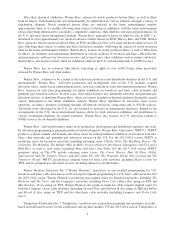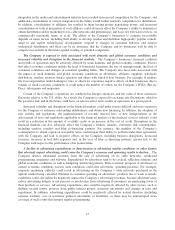Time Magazine 2013 Annual Report Download - page 24
Download and view the complete annual report
Please find page 24 of the 2013 Time Magazine annual report below. You can navigate through the pages in the report by either clicking on the pages listed below, or by using the keyword search tool below to find specific information within the annual report.television networks and pay television programming services. The theatrical success of a feature film is a
significant factor in determining the revenues it is likely to generate from the subsequent licensing of such film to
television networks and pay television programming services. Warner Bros.’ television product revenues are
generated principally from the licensing of programs to domestic and international television networks, television
station groups and premium pay television services.
Warner Bros. also generates revenues through home video distribution of its theatrical and television product
on DVD, Blu-ray Discs and various digital formats (e.g., EST and VOD). In recent years, home video revenues
have declined as a result of several factors, including consumers shifting to subscription rental services and
discount rental kiosks; changing retailer initiatives and strategies (e.g., the reduction of floor space devoted to
Blu-ray Discs and DVDs); retail store closures; the general economic downturn in the U.S. and many regions
around the world; increasing competition for consumer discretionary time and spending; and piracy. In response
to these declines, Warner Bros. is working to make digital ownership more compelling for consumers through
support of initiatives such as UltraViolet, the home entertainment industry standard that allows consumers who
have purchased film and television content to access their content at any time by downloading or streaming it
from the cloud to various devices supported by participating UltraViolet retailers. Warner Bros. also generates
theatrical and television product revenues through licenses of motion pictures and television programming to
SVOD services.
In addition, Warner Bros. generates revenues from the development and distribution of videogames in
traditional console and digital formats. It also generates license fees and royalties from the license to
manufacturers, publishers, retailers, theme park operators and other licensees of the names, likenesses, images,
logos and other representations of characters and copyrighted material from motion pictures and television series
produced or distributed by Warner Bros. Licensing revenues are typically derived from royalties that are based
on the licensee’s revenues.
Warner Bros. produces feature films both wholly on its own and under co-financing arrangements with
others and also distributes its own films and films produced by other companies. Warner Bros.’ feature films are
produced under the Warner Bros. Pictures and New Line Cinema banners. Warner Bros.’ feature film strategy
focuses on offering a diverse slate of feature films with a mix of genres, talent and budgets that includes several
“event” films each year and building and leveraging franchises, such as Batman,The Hangover,Harry Potter,
The Hobbit,The Lord of the Rings and Superman. Warner Bros. considers a number of factors, including
competition and the timing of vacation and holiday periods, in selecting release dates for its feature films.
During 2013, Warner Bros. released 18 original feature films for theatrical exhibition in the U.S., including
The Conjuring,Gravity,The Great Gatsby,The Hangover Part III,The Hobbit: The Desolation of Smaug,Man
of Steel and We’re the Millers. Of the films released during 2013, six were released in 3D format, including
Gravity,The Great Gatsby and The Hobbit: The Desolation of Smaug, and five of the films released during 2013
were formatted for viewing on IMAX screens, including Gravity and The Hobbit: The Desolation of Smaug.In
addition, The Hobbit: The Desolation of Smaug was released in high frame rate format for viewing on a limited
number of screens. Warner Bros. released 4 movies in the first quarter of 2014, including The Lego Movie and
300: Rise of an Empire, and plans to release 16 additional films in the U.S. throughout the year, including Edge
of Tomorrow,Godzilla, The Hobbit: There and Back Again, Horrible Bosses 2 and Jupiter Ascending. Of the
original feature films expected to be released during 2014, Warner Bros. expects to release six in 3D format and
six formatted for viewing on IMAX screens. In September 2013, Warner Bros. announced that it had entered into
an expanded creative arrangement with author J.K. Rowling that involves a new film series from Rowling’s
world of witches and wizards, inspired by Harry Potter’s Hogwart’s textbook, Fantastic Beasts and Where to
Find Them.
Warner Bros. also distributes feature films for theatrical exhibition in more than 125 international territories.
In 2013, Warner Bros. released internationally 19 English-language films and 28 local-language films that it
either produced itself or acquired from other companies. Feature films released theatrically in the U.S. generally
are released in international territories either the same day as the domestic release or following a staggered
release schedule.
8
























